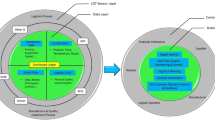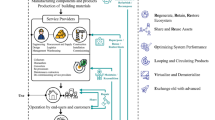Abstract
Information and product visibilities have been crucial in today’s supply chain processes, as economic, environmental and social sustainability concepts, which have been frequently focused on in recent years, prioritize the transparency of business processes. Blockchain technology, with continuously expanding application areas, has been revealed to be applicable in supply chain processes. On the other hand, integration of blockchain technology into supply chain processes will not be as smooth as estimated, since some challenges and constraints have already been identified. Therefore, companies aiming to integrate blockchain into supply chain processes should qualify and investigate each of these challenges. In the literature, to the best of the authors’ knowledge, there is no study addressing the issues arising during the integration process. Moreover, most studies related to blockchain technology have merely examined the positive aspects. This study, on the contrary, discusses the technologic, financial, organizational and environmental challenges that are confronted on a sectoral basis during the integration process. The fuzzy AHP and fuzzy TOPSIS methods, which are used in uncertainties and are capable of simultaneous multi-criteria evaluation, were employed. Furthermore, it is intended to produce a study that is of benefit to industrial actors by analyzing the findings related to the challenges merging during technological transformation. The outputs of this study are as follows: (i) High investment costs, data security and utility are important; (ii) integration is harder for the health and logistic sectors; (iii) the supply chains, which are less complicated, will be able to coordinate faster than the blockchain technology does. Consequently, the obtained results are evaluated, and strategic outputs are shared for the decision-makers aiming to integrate blockchain technology into the supply chain processes.



Similar content being viewed by others
References
Andrychowicz M, Masny D, Persichetti E (2015) Leakage-resilient cryptography over large finite fields: theory and practice. In: International conference on applied cryptography and network security. Springer, Cham, pp 655–674
Ateş NY, Çevik S, Kahraman C, Gülbay M, Erdoğan SA (2006) Multi attribute performance evaluation using a hierarchical fuzzy TOPSIS method. In: Fuzzy applications in industrial engineering. Springer, Berlin, Heidelberg, pp 537–572
Baud-Lavigne B, Agard B, Penz B (2014) Environmental constraints in joint product and supply chain design optimization. Comput Ind Eng 76:16–22
Beck R (2018) Beyond bitcoin: the rise of blockchain world. Computer 51(2):54–58
Biswas B, Gupta R (2019) Analysis of barriers to implement blockchain in industry and service sectors. Comput Ind Eng 136:225–241
Bohme R, Christin N, Edelman B, Moore T (2015) Bitcoin: economics, technology, and governance. J Econ Perspect 29(2):213–238
Boström M, Jönsson AM, Lockie S, Mol AP, Oosterveer P (2015) Sustainable and responsible supply chain governance: challenges and opportunities. J Clean Prod 107:1–7
Britchenko I, Cherniavska T, Cherniavskyi B (2018) Blockchain technology into the logistics supply chain implementation effectiveness. In: Britchenko I, Polishchuk Y (eds) Development of small and medium enterprises: the Eu and east-partnership countries experience, pp 161–173
Buckley JJ (1985) Fuzzy hierarchical analysis. Fuzzy Sets Syst 17(3):233–247
Büyüközkan G, Çifçi G (2012) A combined fuzzy AHP and fuzzy TOPSIS based strategic analysis of electronic service quality in healthcare industry. Expert Syst Appl 39(3):2341–2354. https://doi.org/10.1016/j.eswa.2011.08.061
Çalık A, Paksoy T, Yıldızbaşı A, Pehlivan NY (2017) A decentralized model for allied closed-loop supply chains: comparative analysis of interactive fuzzy programming approaches. Int J Fuzzy Syst 19(2):367–382
Chen ZS, Li M, Kong WT, Chin KS (2019a) Evaluation and selection of hazmat transportation alternatives: a PHFLTS-and TOPSIS-integrated multi-perspective approach. In J Environ Res Public Health 16(21):4116
Chen ZS, Yang Y, Wang XJ, Chin KS, Tsui KL (2019b) Fostering linguistic decision-making under uncertainty: a proportional interval type-2 hesitant fuzzy TOPSIS approach based on Hamacher aggregation operators and andness optimization models. Inf Sci 500:229–258
Cheng CH (1997) Evaluating naval tactical missile systems by fuzzy AHP based on the grade value of membership function. Eur J Oper Res 96(2):343–350
de FSM Russo R, Camanho R (2015) Criteria in AHP: a systematic review of literature. Procedia Comput Sci 55:1123–1132
Dev JA (2014) Bitcoin mining acceleration and performance quantification. In: 2014 IEEE 27th Canadian conference on electrical and computer engineering (CCECE). IEEE, pp 1–6
Galvez JF, Mejuto JC, Simal-Gandara J (2018) Future challenges on the use of blockchain for food traceability analysis. TrAC Trends Anal Chem 107:222–232
Hawlitschek F, Notheisen B, Teubner T (2018) The limits of trust-free systems: a literature review on blockchain technology and trust in the sharing economy. Electron Commer Res Appl 29:50–63
Hwang C, Yoon K (1981) Multiple attribute decision making: methods and application. Springer, New York
Junior FRL, Osiro L, Carpinetti LCR (2014) A comparison between fuzzy AHP and fuzzy TOPSIS methods to supplier selection. Appl Soft Comput 21:194–209
Kapil V (2014) BitCoin: a new paradigm in E–commerce. Int J Adv Res Comput Commun Eng 3(9):8072–8077
Korpela K, Hallikas J, Dahlberg T (2017) Digital supply chain transformation toward blockchain integration. In: Proceedings of the 50th Hawaii international conference on system sciences
Nakamoto S (2008) Bitcoin: a peer-to-peer electronic cash system. https://bitcoin.org/bitcoin.pdf. Accessed 25 Apr 2019
Niranjanamurthy M, Nithya BN, Jagannatha S (2019) Analysis of blockchain technology: pros, cons and SWOT. Clust Comput 22(6):14743–14757
Paksoy T, Pehlivan NY, Kahraman C (2012) Organizational strategy development in distribution channel management using fuzzy AHP and hierarchical fuzzy TOPSIS. Expert Syst Appl 39(3):2822–2841
Pilkington M (2016) Blockchain technology: principles and applications. In: Olleros FX, Zhegu M (eds) Research handbook on digital transformations. Edward Elgar Publishing, Cheltenham, pp 1–39
Queiroz MM, Wamba SF (2019) Blockchain adoption challenges in supply chain: an empirical investigation of the main drivers in India and the USA. Int J Inf Manage 46:70–82
Reyna A, Martín C, Chen J, Soler E, Díaz M (2018) On blockchain and its integration with IoT. Challenges and opportunities. Future Generat Comput Syst 88:173–190
Saaty TL (1980) The analytic hierarchy process: planning priority setting. McGraw Hill, New York
Saberi S, Kouhizadeh M, Sarkis J, Shen L (2019) Blockchain technology and its relationships to sustainable supply chain management. Int J Prod Res 57(7):2117–2135
Scott B, Loonam J, Kumar V (2017) Exploring the rise of blockchain technology: towards distributed collaborative organizations. Strategic Change 26(5):423–428
Sinimole KR (2012) Performance evaluation of the hospital services - A fuzzy analytic hierarchy process model. Int J Prod Qual Manag 10(1):112–130. https://doi.org/10.1504/IJPQM.2012.047944
Svensson G (2009) The transparency of SCM ethics: conceptual framework and empirical illustrations. Supply Chain Management 14(4):259–269
Swan M (2015) Blockchain: blueprint for a new economy. O’Reilly Media, Inc, Newton
Tanco M, Jurburg D, Escuder M (2015) Main difficulties hindering supply chain performance: an exploratory analysis at Uruguayan SMEs. Supply Chain Manag Int J 20(1):11–23
Tian F (2016) An agri-food supply chain traceability system for China based on RFID and blockchain technology. In: 13th International conference on service systems and service management (ICSSSM). IEEE
Treiblmaier H (2018) The impact of the blockchain on the supply chain: a theory-based research framework and a call for action. Supply Chain Manag Int J 23(6):545–559
Underwood S (2016) Blockchain beyond bitcoin. Commun ACM 59(11):15–17
Usta A, Dogantekin S (2017) Blockchain 101. Kapital Medya Hizmetleri A.Ş., ISBN: 978-605-4584-97-0, İstanbul
Vasek M, Thornton M, Moore T (2014) Empirical analysis of denial-of-service attacks in the Bitcoin ecosystem. In: International conference on financial cryptography and data security. Springer, Berlin, pp 57–71
Verma D, Desai N, Preece A, Taylor I (2017) A block chain based architecture for asset management in coalition operations. In: Ground/air multisensor interoperability, integration, and networking for persistent ISR VIII. International Society for Optics and Photonics, vol 10190, p 101900Y
Vukolić M (2015) The quest for scalable blockchain fabric: proof-of-work vs. BFT replication. In: International workshop on open problems in network security. Springer, Cham, pp 112–125
Yıldızbaşı A, Üstünyer P (2019) Blockchain design in agricultural food supply chain: example of marketplace law in Turkey. Bartın Orman Fakültesi Dergisi 21(2):458–465
Yli-Huumo J, Ko D, Choi S, Park S, Smolander K (2016) Where is current research on blockchain technology?—a systematic review. PLoS ONE 11(10):1–27
Zadeh LA (1965) Fuzzy set. Inf Control 8(3):338–353
Zheng Z, Xie S, Dai H, Chen X, Wang H (2017). An overview of blockchain technology: Architecture, consensus, and future trends. In: 2017 IEEE international congress on big data (BigData congress). IEEE, pp 557–564
Zohar A (2015) Bitcoin: under the hood. Commun ACM 58(9):104–113
Acknowledgements
We would like to show our gratitude to the “anonymous” companies for sharing their information and wisdom with us during the course of this research, and we thank our decision-makers for their so-called insights and valuable comments.
Author information
Authors and Affiliations
Corresponding author
Ethics declarations
Conflict of interest
The authors declare that they have no conflict of interest.
Ethical approval
This article does not contain any studies with human participants or animals performed by any of the authors.
Additional information
Communicated by V. Loia.
Publisher's Note
Springer Nature remains neutral with regard to jurisdictional claims in published maps and institutional affiliations.
Rights and permissions
About this article
Cite this article
Öztürk, C., Yildizbaşi, A. Barriers to implementation of blockchain into supply chain management using an integrated multi-criteria decision-making method: a numerical example. Soft Comput 24, 14771–14789 (2020). https://doi.org/10.1007/s00500-020-04831-w
Published:
Issue Date:
DOI: https://doi.org/10.1007/s00500-020-04831-w




